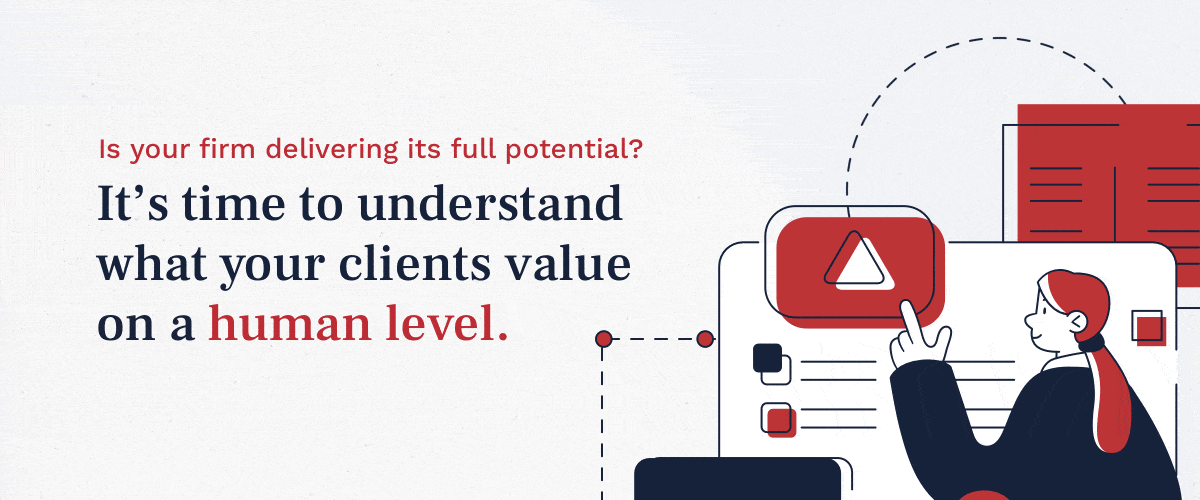You’re likely familiar with Maslow’s hierarchy of needs, the famous and oft-quoted (and misquoted) psychological model that shows how human motivations evolve, starting with the physiological (air, food, shelter) and progressing to loftier goals of self-actualization (morality, creativity, fulfillment).
Less well-known: Bain & Company’s Elements of Value pyramid, which similarly charts the four kinds of needs of humans buying goods and services. It’s a model that’s especially relevant for the legal profession, where it can be hard to achieve brand differentiation based on services; instead, by focusing on what clients value on a human level, law firms increase both revenue and loyalty.
The Bain model includes 30 elements of value, sorted into four categories; starting from the bottom and moving up, they are:
Category |
Values |
Examples |
| Functional | Help me do something better | Save time Make money Reduce risk Reduce cost Reduce effort |
| Emotional | Help me feel better | Provide access Enhance wellness |
| Life Changing | Improve my situation | Provide hope Provide affiliation/belonging |
| Social Impact | Help me realize my best self | Achieve self-transcendence |
As one climbs the pyramid, the emotional connection gets stronger – we feel the strongest about goods and services that affect our inner selves – but the marketing gets harder. (This makes sense: far more products are functional than life-changing.)
After developing this model, Bain & Company put it to the test, and two of their findings are specifically relevant to law firms:
- Loyalty: Companies that perform well on multiple elements of value have higher loyalty. Indeed, companies with high scores on four or more of the 30 elements, on average, outperformed companies with a high score in just one category by three times. For companies with no high scores? Twenty times.
- Revenue: Companies that do well on multiple elements grow faster. Companies that scored high on four or more elements had revenue growth four times greater than companies with just one high score.
And this isn’t accidental: As the Bain & Company researchers write in Harvard Business Review, “the winning companies understand how they stack up against competitors and have methodically chosen new elements to deliver over time.”
Every day, law firms provide potential value – not in terms of summary judgment or letters of intent, but in real human emotions. Where we fail is to deliver it in a human fashion that connects with our human clients.
How could law firms better position themselves using the Elements of Value? Consider these examples of purposeful execution:
Functional
- Reduces risk: Can you quantify your risk prevention and share that at the end of the matter? (And separate from the invoice?)
- Makes money: Can you show how your work isn’t a sunk cost, but makes money? This is straightforward for contingency firms but just as possible after a creative settlement, licensing agreement, et cetera.
- Reduces cost: What solutions have you brought (alternative fees, legal tech) that lower legal expense, and how can you quantify that?
Emotional
- Provides access: How could you leverage your firm’s contacts to help clients see that you expand their networks? This can look like an executive roundtable, an elected official meet-and-greet, a sneak peek at a new development project.
- Reduces anxiety: If your primary goal was to reduce a client’s anxiety, how would that change how you communicate on budgets, matter status and more?
Life Changing
- Affiliation and belonging: Can you provide meaningful connections with peer groups? How do you validate new in-house counsel or new executives – and help them feel more confident in their roles?
One note of caution: While these attributes (and others) are well within reach of law firms, the Bain & Company research team found that one attribute affects customer advocacy more than any other element. It’s quality, and “no other elements can make up for a significant shortfall on this one.”
We’ve talked before about why law firm brands fail; two of the top reasons are focusing on features, not benefits, and telling, not showing. (“We have 100 employment lawyers” versus “Our employment lawyers handle retaliation claims like yours every day, and here’s our track record to prove it.”)
The Elements of Value framework provides a helpful reminder that we are selling services to humans – even if they are humans working on behalf of international conglomerates – and can spark important ideas on how you serve and report to your clients.

